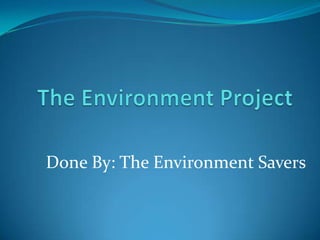
The Enivronment Project
- 1. The Environment Project Done By: The Environment Savers
- 2. Contents Main Theme The Project Purpose About Earth What May Happen To The Earth Things That Have Been Done Credits
- 3. Main Theme :Conservation of Natural Resources VS The Environment The Earth’s natural resources are depleting faster than man can replace them. Forests are being cut down at an alarming rate and Earth’s temperature is increasing due to global warming. The growing world population has put pressure on Earth’s natural resources and many times, the argument is about development versus the environment.
- 4. The Project Purpose Protecting Our Earth
- 5. About Earth Earth is the third planet from the Sun and the fifth largest. Earth is the only planet whose English name does not derive from Greek/Roman mythology. The name derives from Old English and Germanic. There are, of course, hundreds of other names for the planet in other languages. In Roman Mythology, the goddess of the Earth was Tellus - the fertile soil It was not until the time of Copernicus (the sixteenth century) that it was understood that the Earth is just another planet.
- 6. What may happen to the Earth Poles Being Switched!!!
- 7. Study show poles may be Switching The Earth's magnetic field may flip towards the end of the next millennium according to Danish geophysicists, exposing the Earth to harmful cosmic radiation in the process. In the past century, the magnetic north pole has moved over 1000 km towards the geographical north pole, and over the past decade the strength of the magnetic field has fallen by 1%. New measurements made in Greenland by the Danish Meteorological Institute (DMI) show that the magnetic north pole is moving northwards at 20 km a year - 2 km a year faster than 12 months ago.
- 8. What exactly causes pole switching? "The Earth's magnetic field is thought to be generated by fluid motions in the liquid, outer part of the Earth's core, which is mainly composed of iron. The fluid motions are driven by buoyancy forces that develop at the base of the outer core as the Earth slowly cools and iron condenses onto the solid, inner solid core below. The rotation of the Earth causes the buoyant fluid to rise in curved trajectories, which generate new magnetic field by twisting and shearing the existing magnetic field. Over 99 percent of the Earth's magnetic energy remains confined entirely within the core. We only observe the small portion of the magnetic field that extends to the surface and beyond, where its basic structure is a dipole--that is, a simple north-south field like that of a simple bar magnet. There are also smaller, non-dipolar structures in the Earth's field; these change locally and very slightly on a century timescale.
- 9. More information about the causes "The dipole part of the field is usually aligned fairly closely with the Earth's rotation axis; in other words, the magnetic poles are usually fairly close to the geographic poles, which is why a compass works. Occasionally, however, the dipole part of the field reverses, causing the locations of the north and south magnetic poles to switch. This reversal process can be seen in the paleomagnetic record, locked into rocks of the ocean floor and in some lava flows. The reversal process is not literally 'periodic' as it is on the sun, whose magnetic field reverses every 11 years. The time between magnetic reversals on the Earth is sometimes as short as 10,000 years and sometimes as long as 25 million years; the time it takes to reverse is only about 5,000 years.
- 10. Things that have been done: Earth Hour 2010
- 11. Earth Hour 2010 Peoples off their lights for 1 hour during the Earth Hour 2010. By doing this, it will save a lot of electricity used. One-hour effort at Changi’s terminals is estimated to yield energy savings equivalent to the total amount of electricity used by a typical four-room HDB apartment over almost three months. Changi airport generate about 950 kilowatts hours of energy a day , resulting in energy savings of some $6o,ooo a year.
- 12. The Team: JavenTeo Loh Jin An Loke Yi Guang Ng Jie Le (33) Sean Toh Han Yang (35) Tan Phee Boon (36) Credits